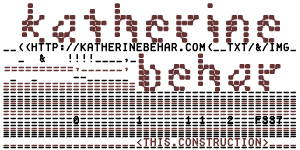
Title: Anonymous Autonomous (WIP Exhibitions)
Media: Modified office chairs, motors, sensors, custom electronics, custom software, computers, vinyl, paper, sound.
Year: 2018–ongoling.
Presented:
- "Anonymous Autonomous Pop-Up." Public project showcase. Robotics Institute Atrium, University of Michigan, Ann Arbor, MI, USA. January 28, 2022.
- "Anonymous Autonomous Work in Progress Community Demo." Solo exhibition. Duderstadt Center Gallery, University of Michigan, Ann Arbor, MI, USA. December 13–21, 2019.
- "Katherine Behar: Anonymous Autonomous." Solo exhibition curated by Andrew Ames and Christine Holtz. Media Arts Gallery, Robert Morris University, Pittsburgh, PA, USA. January–February, 2018.
Credits:
Anonymous Autonomous was developed through generous support from the University of Michigan's Stamps School of Art and Design, Institute for Research on Women and Gender (IRWG), the Center for Ethics, Society, and Computing (ESC), and the Robotics Institute, as well as ArtsEngine and UROP (2019–ongoing); and the RMU Media Arts Visiting Artist and Scholar Program and a Pioneer Works Tech Residency (2017–2018); and was further made possible, in part, by support from the Weissman School of Arts and Sciences at Baruch College, City University of New York, a PSC-CUNY Award, jointly funded by the Professional Staff Congress and the City University of New York, and The MacDowell Colony.
2022 VERSION [Supported by University of Michigan Residency]
Software Engineering Lead: Fee Christoph
Software Team: James Kennedy
Hardware Engineering Lead: Karthik Urs
Hardware Team: Becca Cuomo
Duderstadt Support: Tom Bray
Photography: David Cecchetto (Images 1, 3, 4, 5, 7, 8, 9, 10, 11, 12), Tom Bray (Image 6) and Dan Newman (Image 2)
Video: Dan Newman.
Special thanks to the students, faculty, staff, and community at University of Michigan, Stamps School, Robotics Institute, IRWG, ESC, Duderstadt, ArtsEngine, and UROP, in particular: Irina Aristarkhova, Guna Nadarajan, Anna Kirkland, Michael Lee, Nicole Perry, Damen Provost, and Christian Sandvig, and especially the students at UM: Fee Christoph, Becca Cuomo, James Kennedy, and Karthik Urs
2019 VERSION [Supported by University of Michigan Residency]
Software Engineering Lead: Fee Christoph
Software Team: James Kennedy, Aian Cowart
Hardware Engineering Lead: Michael Ploof
Hardware Team: Becca Cuomo, Karthik Urs
Duderstadt Support: Tom Bray
Photography: Jared Haas (Images 1, 2, 3, 4, 5, 6, 10, 11, 12) and Rachel London (Images 7, 8, 9)
Video: Jared Haas (camera).
Special thanks to the students, faculty, staff, and community at University of Michigan, Stamps School, ESC, IRWG, Duderstadt, ArtsEngine, UROP, and especially the undergraduate students at UM: Fee Christoph, Aian Cowart, Becca Cuomo, James Kennedy, and Karthik Urs
2018 VERSION [Supported by RMU and PioneerWorks Residencies]
Computer vision software design: Tommy Martinez
Hardware Engineering: Gabe Cottrell
Arduino: David Sheinkopf
Photography: Sean Carroll (Images 1, 2, 3, 4, 5, 6, 7, 8, 9, 13, 14), Dominique Murray Photography (Images 10, 12), Katey Ladika (Images 11, 15, 16, 17), Carmen Swasey Photography (Image 18)
Video: Leslie Koren (camera).
Special thanks to the students, faculty, staff, community, and Department of Media Arts at Robert Morris University: Andrew Ames, Lindsay Bostwick, Gabe Cottrell, Kaylee Coyle, Tim Hadfield, Christine Holtz, Leslie Koren, Cole Miller, Britta Moletz, David Scott, Arif Sirinterlikci, Conrad Snyder, Patty Then, Chad Wertley, Helena Vanhala, Hyla Willis, Ben Z, Abby Zorich









































